![]()
A system is never the sum of its parts; it’s the product of their interaction.
—Russel Ackoff
Solution Train Engineer
The Solution Train Engineer (STE) is a servant leader and coach for the Solution Train, facilitating and guiding the work of all ARTs and Suppliers in the Value Stream.To succeed in the Digital Age, organizations must efficiently build and evolve large, complex solutions that fulfill the most critical functions for their customers. This effort, which may involve hundreds or even thousands of knowledge workers, is rewarding and highly challenging. Building such solutions quickly, however, is difficult and requires a robust process of creating value, learning, and adapting. Systems of this complexity require a special role to coordinate, facilitate, and help to guide the constituent ARTs toward productive outcomes. That’s the role of a Solution Train Engineer (STE). STEs enable effective operations of the Solution Train’s ARTs, which require decentralized decision-making, alignment, and coordination for the entire Solution Train.
Details
The Solution Train Engineer (STE) possesses a systems view of the entire development and delivery process. This is a challenging task because a Solution Train involves multiple ARTs that must operate and improve simultaneously. The critical SAFe practices that govern the Solution Train effort, which the STE must facilitate, focus on the whole Value Stream. The foundation of these practices is the Solution Train’s PI cadence, the heartbeat of the development effort at the highest solution level.
In a solution train, the actual development work is done by the Agile Release Trains (ARTs) that create a large solution’s components, subsystems, and capabilities. The Solution Train provides the “connective tissue” between the enterprise’s intent and the actual implementation. The STE must establish the critical connectivity between those who bring centralized initiatives to the table and those who ultimately implement them.
Each Solution Train is anchored by three critical roles from Figure 1.
The roles provide crucial support to one another. Without proper assistance from Solution Management and Solution Architect, the STE cannot help the Solution Train proceed in the right direction. Likewise, without the STE, the other two roles will have difficulty translating their intent into a working, valuable solution.
Apart from directly facilitating Solution Train’s operations, the STE acts as a Lean-Agile Leader to the train and often as a coach to the Release Train Engineer (RTE) community. That may include other roles in the ART regarding Lean and Agile practices. The STE helps individual ART stakeholders and RTEs understand their impact on the bigger picture of solution development, establishing the right balance of centralized vs. decentralized decision-making.
Responsibilities
Generally, the STE’s responsibility comes from four distinct areas, as described below.
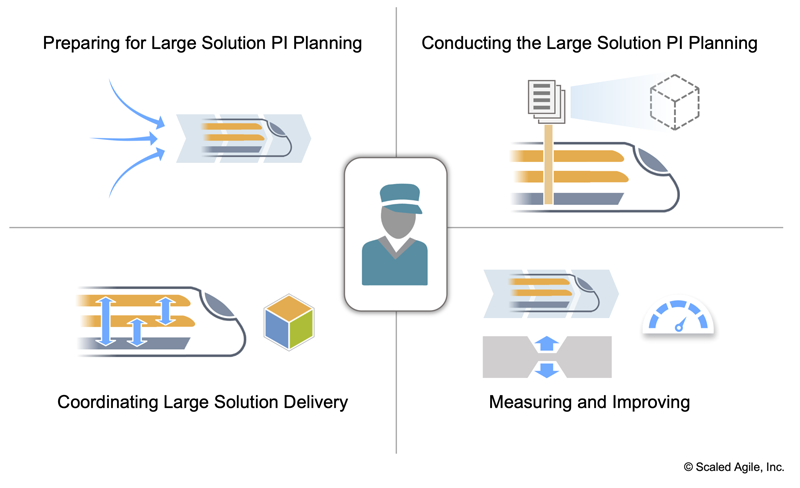
Preparing for Large Solution PI Planning

A typical Solution Train has many input sources and a variety of business and technical stakeholders. As a result, every PI Planning event for a Solution Train requires careful preparation. Although preparation for PI planning is most intense during the IP iteration—culminating at the Pre-Planning session—some activities may occur in prior iterations.
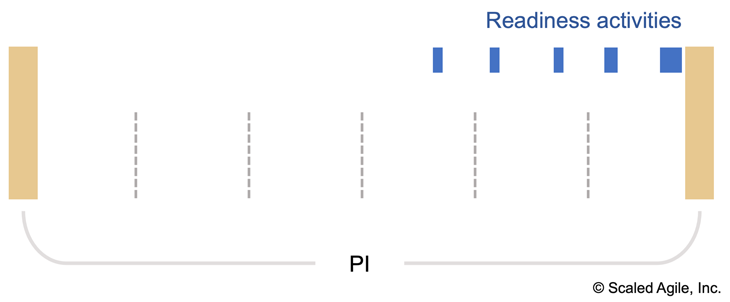
When to start the readiness process depends on the particular Solution Train context. However, the optimum approach avoids making decisions too early or too late, without leaving enough time to reconcile the implications (potentially running stale by PI Planning).
During preparation for PI Planning, the STE has many interactions with multiple stakeholders. One of the primary responsibilities of the STE role is being a relationship builder, establishing vital connections within and outside the Solution Train to help the group operate as a collaborative, adaptive network.
As the Solution Train approaches the PI boundary, the STE needs to focus on the following:
- Update the solution vision and roadmap – Solution train leaders must communicate the solution Vision and Roadmap with adequate time for ARTs to teams to plan the PI. Solution Management and select Solution Train stakeholders usually perform this work. STEs ensure that this happens promptly and in a way that is consumable by ARTs. They also ensure the Solution Architect and the train’s technology stakeholders provide the technology vision that guides the solution architecture and implementation strategy
- Facilitate solution backlog preparation – As the PI boundary approaches, Solution Management must refine the Solution Backlog. However, a significant portion of a Solution Train’s work may emerge locally within the ARTs. The STE works with the RTEs to ensure the ARTs are well-prepared for the upcoming PI.
- Help discover external dependencies – Planning preparation often involves identifying important external dependencies, which can be facilitated as a series of activities or as a single, dedicated event. Understanding high-level dependencies ahead of PI Planning allows the Solution Train to avoid disconnects and duplicate efforts. This also establishes necessary interactions with other parties critical to their success in the upcoming PI.
- Prepare and communicate Solution Train PI Planning agenda – A Solution Train may involve complex interactions across its constituent ARTs, affecting the Solution’s PI Planning event’s structure (duration, time zone overlaps, sync points, etc.). STEs prepare the planning agenda and communicate it to all RTEs with sufficient time to make local adjustments.
- Ensure proper participation in PI planning – Depending on the upcoming work and the structure of external dependencies, specific stakeholders need to be involved in the Solution PI Planning. They will bring new work, are responsible for funding and strategy, or provide insights on customer or business outcomes. STEs ensure stakeholders’ preparation and attendance for the PI Planning event. Additionally, different PI Planning sessions at the Solution level may involve various representatives from the ARTs. The STE has to orchestrate all this participation carefully.
- Help the Solution Train assess its capacity – To help understand the Solution Train’s ability to deliver, STEs collect appropriate PI measures. These include PI predictability, overall Solution Train capacity, and capability/feature throughput. Some Solution Trains find it helpful to create a preliminary capability and feature layout across iterations of the new PI. While this forecast helps to scope the work based on Solution Train capacity, only the teams may commit to a particular course of action.
Conducting the Large Solution PI Planning
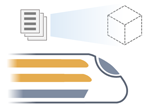
Although ART PI Planning varies somewhat across trains, experience has shown that Solution Train PI Planning differs even more. Most of the Solution Trains are too large to follow the same process for PI. However, there are multiple successful planning patterns for Solution Trains that have emerged.
Figure 4 illustrates one common and somewhat ideal planning pattern:
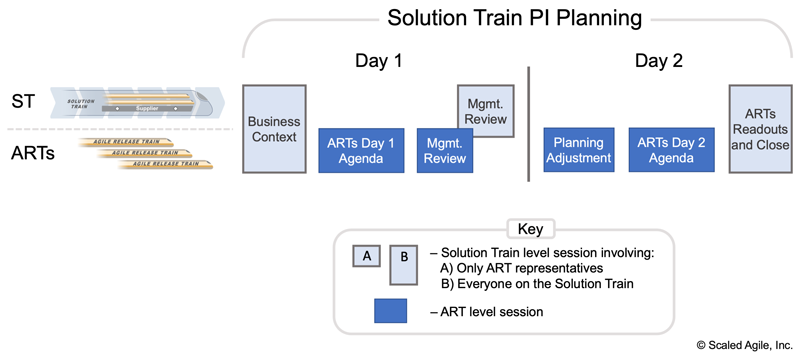
In this example, the Business Context is presented to everyone (all teams across all ARTs). The ARTs then individually continue the first day of planning according to the ART PI planning agenda (performing product and architectural vision briefings, team breakouts, etc.). At the end of the day, select representatives from each ART bring the results of their “Management Review and Problem-Solving” outcomes to the Solution Train. Day 2 follows the typical structure of ART planning, but once each ART completes their plan, consolidated “Readouts” occur across the entire Solution Train.
Based on that structure, there are several key STE responsibilities for PI Planning:
- Facilitate the Solution Train-level planning – Facilitating the PI Planning involves multiple activities; some include Solution Train stakeholders; others also include select ART representatives, and some may include everybody from all the ARTs. Such a “level change” is typical and helps ensure proper planning progression in a large group of people.
- Ensure visibility and effective interaction across ARTs – A Solution Train does not include any teams directly (other than possibly some shared services); all the actual teams belong to the ARTs. Because of this, STEs must have reliable communication with RTEs to quickly respond to impediments during PI Planning and direct their effort where it’s needed most. A good way to keep the planning process on track is to conduct multiple RTE syncs during the planning. Many Solution Trains find it useful to build a solution board patterned after the Agile Release Train program board. An example of a solution board can be found in Pre- and Post Planning article.
- Connect ARTs with the right stakeholders, as needed – At the scale of a Solution Train, it’s common to discover dependencies or the need for additional input during the planning stage versus the preparation stage. That often requires a quick response to connect an ART with certain stakeholders or representatives from other ARTs. STE must ensure ARTs continually have everything they need to plan effectively.
- Summarize PI Planning objectives across the Solution Train – The Solution Train’s PI Planning goal is for the ARTs and teams to commit to a shared plan. To represent this shared vision, STEs create a set of Solution Train objectives. Some Solution Trains find it helpful to create a separate set of aggregated goals. Others simply represent the Solution Train objectives as the collection of the ART objectives.
For highly distributed Solution Trains, or in situations where ARTs may need to stagger their planning, the event may take more than two days. Creating a planning structure suitable for the particular needs of the Solution Train is a vital task for the STE.
Coordinating Large Solution Delivery
 Cadence-based execution is the core of the Solution Train operations. In SAFe, successful execution requires learning cycles as a part of the development process. For Solution Trains, the PI represents such a cycle.
Cadence-based execution is the core of the Solution Train operations. In SAFe, successful execution requires learning cycles as a part of the development process. For Solution Trains, the PI represents such a cycle.
During PI execution, the STE pays special attention to the following areas:
- Facilitate synchronization across the Solution Train – Regular syncs keep the Solution Train on track. Many STEs use weekly syncs involving Solution Management, Solution Architects, Product Management, RTEs, and System Architects from ARTs. The solution board helps focus everyone’s attention on the right deliverables. Some Solution Trains conduct multiple regular sync meetings by area of concern, such as:
- Progress and impediments (STE and RTEs)
- Content of work (STE, Solution Management, ART Product Managers)
- Architecture and technology (STE, Solution and System Architects)
- Ensure frequent solution integration – Frequently integrating the solutions’ parts reduces technical risks and maintains steady progress in large solution development. Effective integration at the solution level is often a challenge. Although the ARTs, in conjunction with the Systems Team, are ultimately responsible for integrating their assets, the STE confirms the ARTs are progressing towards the goal and addresses any impediments. STEs must also ensure that the ARTs understand the importance of solution integration and take specific action towards it. The choice of the integration pattern, infrastructure, and tooling are usually at the discretion of the Solution and System Architects and the respective System Teams.
- Facilitate solution demo – Due to their size, Solution Trains do not always produce an end-to-end Solution Demo at every iteration. However, it is typically critical to integrate and demonstrate the solution repeatedly during the PI. Establishing a mid-PI Solution Demo can be a good start. In addition, and depending on the context, certain System Demos at an individual ART level may have solution significance. They can benefit from the attendance of the Solution Train or, in some cases, even Portfolio stakeholders.
- Establish release coordination activities – Successful execution provides frequent and predictable value delivery. To provide structure to the process, STEs establish a rhythm of release activities within and across the ARTs (e.g., release tracking, release management meetings). Depending on the Solution Train context, release activities may require different degrees of centralized coordination. In some cases, the Solution Train must coordinate all release activities; in others, the function of releasing rests fully with ARTs.
Measuring and Improving
 To survive in the Digital Age, developing and delivering solution capabilities quickly and reliably is critical. Measuring the pace at which a Solution Train operates allows it to improve over time.
To survive in the Digital Age, developing and delivering solution capabilities quickly and reliably is critical. Measuring the pace at which a Solution Train operates allows it to improve over time.
Like any part of a SAFe organization, a Solution Train applies the same metric structure, including the measures of Competency, Flow, and Outcomes (Figure 5).
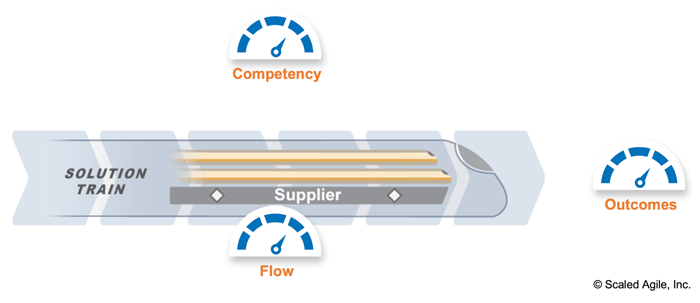
To establish good visibility into the Solution Train’s ways of working, the STE should:
- Establish Solution Train flow measures – To achieve the end-to-end systems view of the Solution Train, STEs must measure the flow of the highest-level items (solution epics and capabilities). Simply aggregating performance indicators from the constituent ARTs won’t do. No matter how quickly each train executes, poorly coordinated ARTs will not produce high throughput at the solution level. Flow measures applied at the solution level focus on the system and reveal the broader solution development and delivery performance.
- Ensure the Solution Train measures outcomes – Value delivery is only successful when it produces the desired customer and business benefits. Therefore, the STE must ensure that the Solution Train’s outcomes are measured and inform future decisions. Value stream KPIs are one common approach to measuring results, performed closely with Solution Management.
- Facilitate solution level I&A – The Solution-Train-level Inspect & Adapt (I&A) event is a regular part of the SAFe improvement process and results in a set of improvement items. Some of those items will directly involve ARTs, so it is useful to synchronize the solution-level I&A with the ART I&A workshops. That way, the value stream remains optimized globally, and substantial performance gains will follow.
Additionally, an Enterprise Solution Delivery assessment can reveal the current strengths and weaknesses of the Solution Train. To support focused improvement efforts, STEs should perform this assessment regularly.
Similarities and Distinctions with the RTE Role
The roles of the STE and the RTE have many similarities. Both facilitate the PI lifecycle events, act as Lean-Agile leaders to their group, and work to cultivate a Lean-Agile mindset and practices in their areas of concern.
But there also are crucial differences that stem from large solutions as they represent larger investments that are critical to achieving the enterprise’s business objectives. As a result, unlike the RTE, the STE is far more exposed to the higher-profile stakeholders and less exposed to the teams that create value. This produces certain advantages and challenges.
First of all, closer proximity to the Portfolio level offers several opportunities to effectively engage with Epic Owners and other business and technology stakeholders who need to interact with the Solution Train. However, unlike the RTE that interacts directly with Agile teams during PI Planning, System Demos, and I&A, the STE is not inherently embedded in the actual execution context. Most of the events the STE facilitates may involve selected representatives from the trains. However, the STE must apply a systemic effort to stay connected with the execution context by:
- Participating in “Gemba walks” alongside other leaders
- Attending relevant ART system demos (particularly when the ART is producing something critical)
- Involving select team members in the Solution Train-level events (primarily when direct input of development team members could be beneficial)
STEs also help connect ARTs to their particular customer, which depends on the nature of the solution and the structure of the Solution Train. For example, when ARTs are organized around subsystems or platforms, customer interactions occur in other parts of the Solution Train. Stream-aligned ARTs often interact directly with their respective customer, so the Solution Train needs to ensure that customer input is aggregated at a higher level.
To create responsive, collaborative networks, STEs need to establish connections to different ecosystem parts.
STE as a Lean-Agile Leader
New STEs typically have many of the organizational and management skills needed to perform their roles. However, to achieve the benefits of Lean-Agile development at scale, they may need to learn and adopt new Lean-Agile Leadership behaviors. As a part of this journey, the STE will have to focus on the following areas:
- Leading by Example – The STE gains earned authority by modeling the desired behaviors for others to follow, inspiring them to incorporate the leader’s example into their own personal development journey.
- Mindset and Principles – By embedding the Lean-Agile way of working into their beliefs, decisions, responses, and actions, the STE establishes the expected organization norms.
- Leading Change – The STE leads the transformation by creating the environment, preparing the people, and cultivating the group behavior that leads to the desired outcomes.
As a Lean-Agile Leader, the STE may need to transition from directing and managing activities to becoming the group’s high-performance enabler. This role focuses on providing the support the teams, ARTs, and Solution Trains need to be self-organizing and self-managing. Actions that characterize the STE as a Lean-Agile Leader include:
- Listening and supporting teams in identifying problems and decision-making
- Creating an environment of mutual influence
- Understanding and empathizing with others
- Encouraging and supporting the development of teams and of each individual
- Coaching people with powerful questions versus using authority
- Thinking beyond day-to-day activities; applying systems thinking
- Supporting the teams’ and trains’ commitments
- Being open and appreciating openness in others
Just as there are Lean-Agile transformational patterns for the Lean Portfolio Management (LPM) function, there are also transformational patterns for a traditional manager moving to become a Lean-Agile leader. The ‘from’ and ‘to’ states are:
- From coordinating team activities and contributions to coaching the teams to collaborate
- From focusing on deadlines to objectives
- From driving toward specific outputs to being invested in the group’s overall performance
- From knowing the answer to asking the teams and ARTs for the answer
- From directing to allowing the teams self-organize and hit their stride
- From fixing problems to helping others solve them
Along with Solution Management and Solution Architect, Solution Train Engineer is one of the three essential roles on the Solution Train. A big part of the STE function is to build relationships within and outside the Solution Train. That helps establish crucial “connectivity” across the involved stakeholders, ARTs, and teams. The STE drives the group’s high performance by:
- Helping the Solution Train prepare and execute PI Planning
- Coordinating large solution delivery
- Measuring and learning how to improve and deliver better outcomes
The Solution Train Engineer leads by example, helping to instill Lean, Agile, and Systems Thinking mindsets to guide the necessary changes that solidify high productivity.
Last update: 14 December 2021





